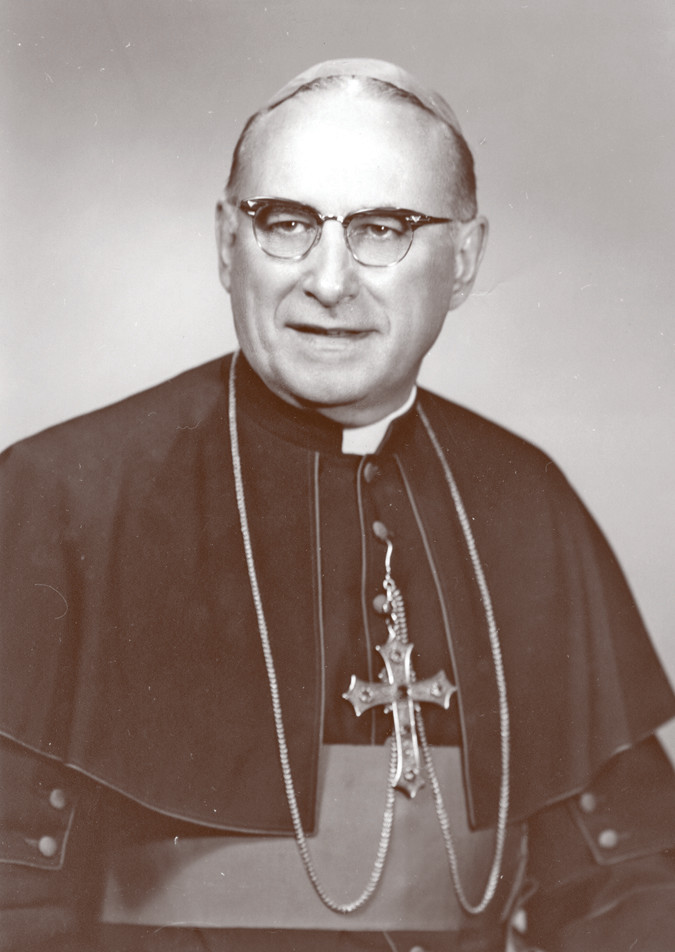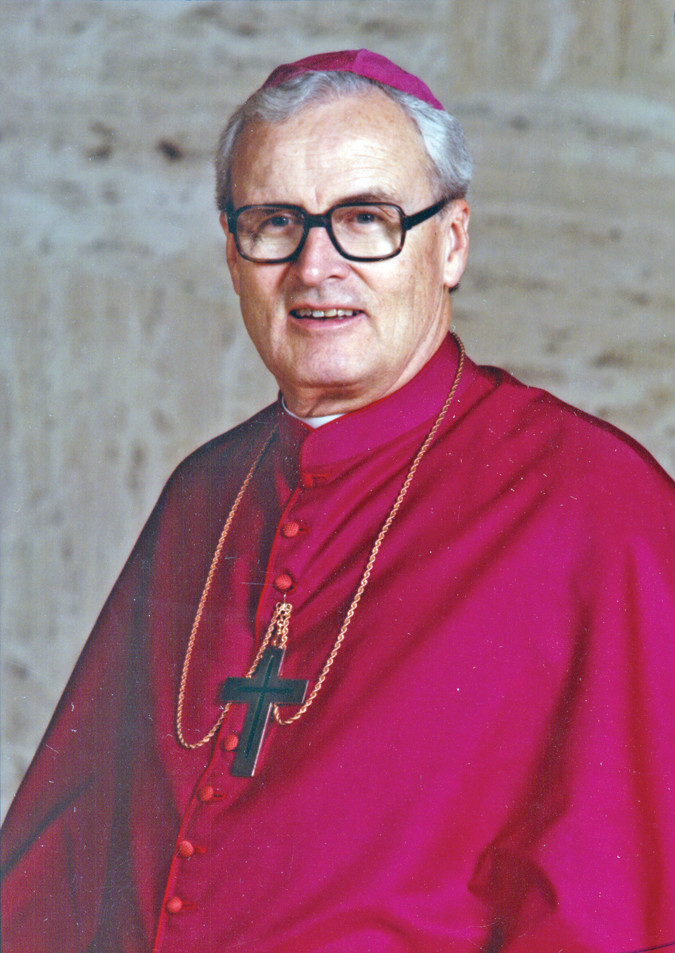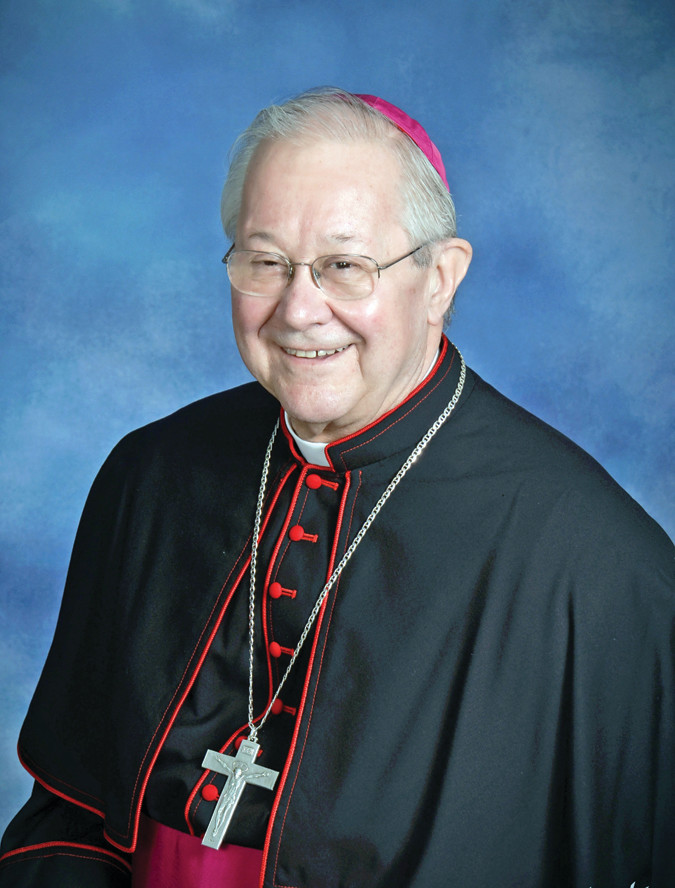Three led the Jefferson City diocese before Bishop McKnight
Here are brief bios of the first three bishops of the Diocese of Jefferson City:
Bishop Joseph M. Marling C.PP.S.
“Per Sanguinem Crucis”
(“Through the Blood of the Cross”)
Bishop Joseph M. Marling C.PP.S. (+1956-1969, RIP 1979), led the diocese through its infancy and united Catholics from three dioceses under his 13-year episcopacy.
He oversaw a period of intense growth and development: the diocese built a cathedral, a chancery and many new churches, schools, rectories and convents.
He cultivated priestly and religious vocations from within the diocese, and invited priests and sisters from elsewhere — including many from Ireland — to serve here.
The diocese opened a high-school seminary for young men in Hannibal; built a Newman Center adjacent to the University of Missouri campus in Columbia; and began the diocesan newspaper, The Catholic Missourian.
He initiated and nurtured the diocese’s massive missionary outreach in Peru. At one time, 10 percent of the diocese’s priests were ministering in the Peru missions.
He attended all four sessions of the Second Vatican Council, then worked to implement the Council’s reforms in the diocese, including the formation of a Priest’s Senate and parish councils.
He established the Sisters’ Association for women religious, organized adult education programs for the laity, and instituted Study Weeks for the priests.
He served as the president of the National Catholic Rural Life Conference and was one of the founding members of the Missouri Catholic Conference in 1967.
He retired as bishop in 1969, then served part-time at Christ the King parish in Kansas City until his death on Oct. 2, 1979.
Bishop Michael F. McAuliffe
“In Truth and Charity”
Bishop Michael F. McAuliffe (+1969-1997, RIP 2006) had the longest tenure of the first three bishops.
He presided over continued growth and maturation of the diocese during his 28-year episcopacy.
Continuing the reforms of the Second Vatican Council, he took special interest in building-up parishes, enhancing Catholic schools and parish religious education programs, and unlocking the largely untapped resources of the laypeople here.
He enthusiastically promoted the diocese’s missionary activities in Peru, the development of priestly and religious vocations, and the deepening of the spirituality and ministry skills of priests and other parish leaders.
He initiated the locally produced three-year “Our Journey in Faith” Catholic program of spiritual renewal of the laity, based on small-group faith-sharing.
He worked toward greater collaboration among priests, religious and laypeople in the ministry and administration in parishes and at the diocesan level.
He began what is now known as the Catholic Stewardship Appeal to subsidize efforts by the diocese to assist the parishes in their work of education and evangelization, and the Diocesan Excellence in Education Fund (DEEF), which continues to boost Catholic school teacher’s salaries.
He served for eight years as chairman of the former National Conference of Catholic Bishops’ ad hoc committee on women in the Church, and hired as diocesan chancellor one of the first women in the country to serve in that role.
Retiring in 1997, he remained in Jefferson City to assist his successor until moving to the Little Sisters of the Poor in Kansas City in 2003.
He died on Jan. 6, 2006.
Bishop John R. Gaydos
“With a Shepherd’s Care”
Bishop John R. Gaydos (+1997-2017) focused on the New Evangelization in the Church through a period of sweeping demographic changes and the fewer priests.
Following a four-year process of renewal and evangelization known as Disciples in Mission, he convened a reconfigured Diocesan Pastoral Council to advise him.
Several churches, schools and Newman centers were built or expanded during his tenure, including Fr. Tolton Regional Catholic High School in Columbia.
He worked with the family and community foundation of the late Alphonse J. Schwartze to build a new diocesan pastoral center, which was completed in 2006.
He oversaw the process of returning to local leadership mission parishes in Peru and expanded the diocese’s foreign-mission efforts to projects in other countries.
He welcomed priests from the Philippines, Nigeria, India, Uganda and other countries to staff parishes here and create new mission partnerships.
With his active support, the number of active permanent deacons grew beyond the number of active priests here.
During the diocese’s 50th anniversary, he urged parishioners looked gratefully to the past and generously to the future, raising $25 million in a capital campaign.
He promoted a diocesan pastoral plan, with emphasis on promoting family life; cultivating a deeper understanding of the faith; creating welcoming parish environments for newcomers, immigrants, the marginalized and the inactive.
One of his last major undertakings was a collaborative process to evaluate and plan for staffing parishes in light of the diminished number of priests.
He plans to continue living and serving in Jefferson City in retirement.











